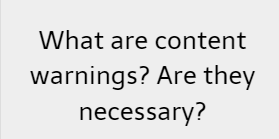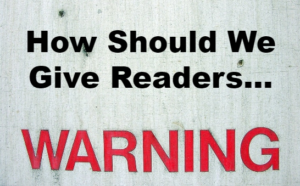Alerting the Imagination: Rethinking Triggers in Publishing
Alerting the Imagination: Rethinking Triggers in Publishing
Siby Shaji
In the evolving landscape of literature, ‘triggers’ serve as alerts for potentially distressing content, sparking debates on the delicate balance between reader well-being and freedom of expression. While aiming to create a safer reading experience, ‘triggers’ face criticism for potentially stifling intellectual growth and creative exploration. The ongoing debate questions whether these cautionary measures infringe on artistic expression and personal choice, akin to warning labels on tobacco products.

Delving into this discussion, we explore perspectives ranging from support for ‘triggers’ as a compassionate gesture to opposition, deeming them unnecessary and inhibitory. Three potential solutions are examined: a voluntary trigger warning system, contextualization of content, and reader education to foster critical thinking. Each presents unique insights, contributing to the ongoing conversation about ‘triggers’ in literature.
Together, we navigate the realms of literature guided by principles of compassion, understanding, and intellectual growth, unraveling the mysteries of ‘triggers’ in the written word.
The Purpose of Triggers

The use of ‘triggers’ in literature stems from a well-intentioned desire to create a safe reading experience for individuals who may have experienced trauma or have specific sensitivities. These warnings serve as a means for readers to make informed choices about the content they engage with, empowering them to avoid potentially harmful material. Proponents argue that by providing such alerts, publishers demonstrate empathy and a commitment to mental health, making literature accessible to a wider audience.
Ridicule and Insult to Intelligence

—Proponents argue that such alerts demonstrate empathy. Critics contend that it underestimates readers’ ability to engage with challenging or potentially offensive ideas.—
Critics of the trigger system contend that it underestimates readers’ ability to engage with challenging or potentially offensive ideas. By issuing explicit warnings, detractors argue that publishers may inadvertently discourage readers from exploring diverse perspectives and grappling with uncomfortable topics. They believe that literature, as an art form, should evoke emotions and encourage critical thinking, and that trigger warnings may hinder this process. Some have even labeled the use of ‘triggers’ as “stupid” and insulting to readers’ intelligence, implying that they are incapable of handling complex themes and narratives without pre-emptive caution.
Drawing Parallels to Health Warnings

The analogy drawn between ‘triggers’ and health warnings on tobacco products raises questions about the potential unintended consequences of such alerts. Just as warning labels on cigarette packs aim to inform consumers about health risks, some argue that trigger warnings may also serve as a form of paternalistic control over what readers should or should not read. This comparison highlights concerns that an overreliance on trigger warnings might lead to self-censorship by authors and publishers, resulting in the sanitization of literature to avoid potential triggers, thereby diminishing the impact of powerful storytelling and authentic expression.
Preserving Freedom of Expression

The principle of freedom of expression lies at the core of democratic societies, ensuring the free flow of ideas, diverse perspectives, and creative works. Advocates for minimal intervention argue that literature should not be diluted or toned down solely to accommodate sensitivities. They fear that an overzealous application of ‘triggers’ could lead to a chilling effect on creative expression, as authors may feel constrained in their storytelling for fear of inadvertently including triggering content. This suppression of creativity could undermine the rich tapestry of human experiences that literature seeks to reflect.
Potential Solutions
1. Voluntary Trigger Warnings:
A voluntary trigger warning system grants authors the autonomy to choose whether to include content warnings for sensitive material in their literary works. This approach respects the diverse creative intentions of authors while acknowledging the readers’ right to make informed choices about their engagement with the content. Shifting away from a one-size-fits-all model, this nuanced perspective encourages a more personalized connection between the author and the reader.
Moreover, the adoption of a voluntary system promotes open communication between authors and readers, fostering a sense of empathy and understanding. Authors who incorporate trigger warnings demonstrate consideration for their audience, allowing readers to feel acknowledged and supported. This approach not only builds trust but also deepens the connection between creators and consumers, extending the impact of the narrative beyond the confines of the written words.

2. Contextualizing Over Warning:
Publishers can embrace a contextualization approach instead of explicit trigger warnings, offering readers brief overviews or introductions to a literary work’s themes and potentially sensitive topics. This method prioritizes transparency, empowering readers to approach the content with heightened awareness.
Contextualization provides readers with a nuanced understanding of a work’s themes without divulging specific plot details, preserving the artistic integrity of the narrative. This approach encourages readers to fully engage with the story, fostering a deeper appreciation for the complexities of character development, societal issues, and moral dilemmas.
However, successful implementation of contextualization hinges on the adeptness of authors and publishers in striking a balance between guiding readers and avoiding spoilers. Additionally, effective marketing and communication strategies are essential to ensure readers are aware of the available contextual information without compromising the story’s integrity

3. Enhancing Reader Education:
An alternative approach to handling sensitive content in literature involves a concerted effort to enhance reader education. By prioritizing media literacy and fostering critical reading skills, readers can develop a more nuanced understanding of the complexities within literary works and their potential impact on emotions and perceptions. Education empowers readers to engage thoughtfully with challenging ideas, enabling them to identify and contextualize triggering content independently. This approach equips readers with the tools to navigate sensitive themes while promoting active and informed reading practices.
To bolster reader education, collaborative efforts among publishers, educators, and literary communities are essential. Initiatives such as workshops, discussion forums, and accessible resources on media literacy and critical reading can be integrated into school curricula and book club discussions, cultivating a more discerning approach to literature and media consumption. However, the successful implementation of a comprehensive reader education strategy requires sustained commitment and collaboration across diverse stakeholders. Overcoming challenges such as limited resources, varying educational standards, and differing cultural contexts is crucial for achieving widespread success in fostering a more informed and engaged reading community.

The debate on ‘triggers’ in literature addresses a complex issue involving both reader and author experiences. Striking a balance between caution and preserving the essence of written works is crucial for a literary landscape that respects reader well-being and creative expression.
In conclusion, a voluntary trigger warning system preserves authorial autonomy while recognizing reader sensitivity, celebrating diversity in storytelling. The contextualization approach promotes transparency, enabling informed choices and fostering a deeper connection with the story. Complementing these, reader education and media literacy empower individuals to engage with challenging content independently, fostering a culture of empathy and open dialogue.
However, implementing these solutions requires collective efforts from authors, publishers, educators, and society. Clear guidelines for trigger warnings and contextualization ensure consistency and transparency without compromising creative integrity. In embracing a holistic approach, we navigate the intricate terrain of sensitive content responsibly, upholding storytelling’s transformative power. As the conversation around ‘triggers’ in literature continues, finding a harmonious middle ground enriches the literary tapestry for generations to come.
Cite this article in APA as: Shaji, S. Alerting the imagination: Rethinking triggers in publishing. (2024, February 6). Information Matters, Vol. 4, Issue 2. https://informationmatters.org/2024/02/alerting-the-imagination-rethinking-triggers-in-publishing/
Author
-
For the past 17 years, I have been employed as a PRT-Librarian at Somerville School Noida. My love for books and storytelling has made me an avid reader, and I take great pleasure in captivating young minds with narrated tales. My primary objective has always been to instill a passion for reading in children, and during library periods, I strive to make the experience engaging through various activities. Writing is another area where my passion lies, and whenever I find the time, I enthusiastically express my thoughts and pen down book reviews as well.
View all posts






